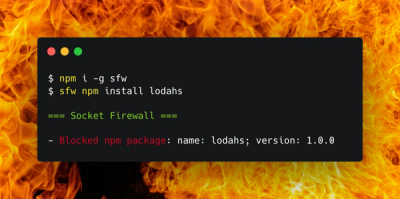
Security News
PodRocket Podcast: Inside the Recent npm Supply Chain Attacks
Socket CEO Feross Aboukhadijeh discusses the recent npm supply chain attacks on PodRocket, covering novel attack vectors and how developers can protect themselves.
rc-receiver-wiringpi
Advanced tools
Decode the PWM signal from an RC transmitter/receiver pair.
$ npm install rc-receiver-wiringpi
A radio control (RC) transmitter sends an encoded signal to an RC receiver. The RC receiver then decodes the signal and produces a pulse width modulated (PWM) representation of the original inputs. To think about this, consider a joystick like a slider. When the slider is at one end, it registers 0, when it is at the other end, it registers 100. If the slider is in between the end points, it registers a value proportional to its position.
An RC transmitter commonly has two joysticks with each joystick able to provide two independent values. Those values are the amount the joystick is north/south and the amount the joystick is east/west. Thus for a transmitter that has two joysticks, there will be a total of four values at any one time. Those values being the amount of north/south on joystick 1, the amount of east/west on joystick 1, the amount of north/south on joystick 2 and the amount of east/west on joystick 2. Each of these data values is transmitted separately by the transmitter in what is called a "channel". The number of channels provided by a transmitter is usually four or more. The channels beyond those described may be associated with buttons and toggle switches.
Since an RC transmitter transmits values on a channel, we would expect the corresponding receiver to receive those channels. An RC receiver exposes some number of channels on PWM pins. Note that the receiver may expose more or less channels than the transmitter transmits. For example, a four channel transmitter may be used with a three channel receiver but, obviously, we will lose one of the channels of information.
When using this package, we connect the signal lines out from the RC receiver into digital input pins on the Pi. This module will then examine those pins when requested and tell us the values currently received from the transmitter.
To use the package, we call:
receiver.init([<arrayOfChannels>]);
where a channel record is composed of:
{
channel: <channelNumber>,
pin: <GPIO pin number>,
invert: <true/false>, // Optional
map: [<lowValue>, <highValue>] // Optional
}
channel is our logical channel number.pin is the GPIO pin number from which we are reading the PWM signal.invert parameter defines whether or not we are inverting the value.map parameter maps the value received from the receiver into a low/high range.Once initialized, we can call getValues() to receive an array of values.
Each value will be record of the format:
{
channel: <channelNumber>
value: <value>
}
The value is a numeric in the range 0 to 100.
FAQs
Access to an RC Receiver
We found that rc-receiver-wiringpi demonstrated a not healthy version release cadence and project activity because the last version was released a year ago. It has 1 open source maintainer collaborating on the project.
Did you know?

Socket for GitHub automatically highlights issues in each pull request and monitors the health of all your open source dependencies. Discover the contents of your packages and block harmful activity before you install or update your dependencies.

Security News
Socket CEO Feross Aboukhadijeh discusses the recent npm supply chain attacks on PodRocket, covering novel attack vectors and how developers can protect themselves.

Security News
Maintainers back GitHub’s npm security overhaul but raise concerns about CI/CD workflows, enterprise support, and token management.

Product
Socket Firewall is a free tool that blocks malicious packages at install time, giving developers proactive protection against rising supply chain attacks.